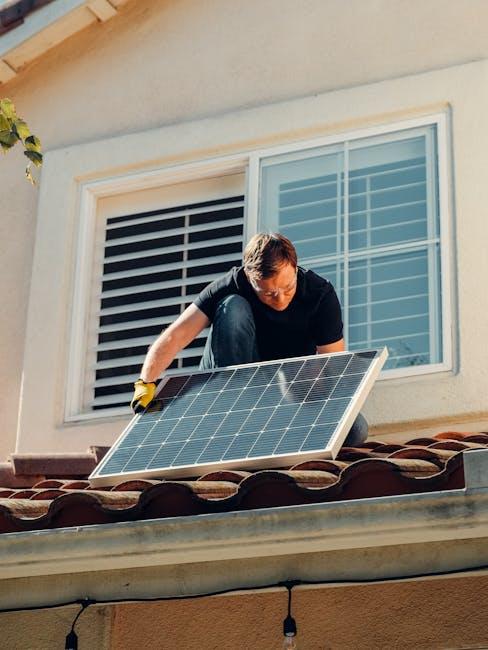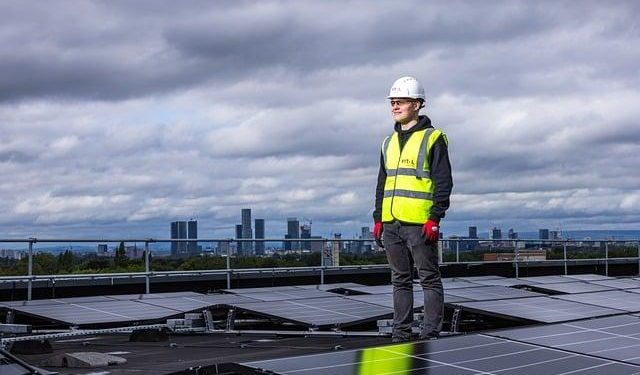In a world increasingly illuminated by the glow of sustainable energy, solar panels stand as silent sentinels on rooftops, capturing the sun’s abundant gifts. Yet, like sunflowers instinctively turning toward the sun, the orientation of these panels plays a pivotal role in their efficiency and effectiveness. As homeowners across the globe embrace the promise of solar energy, understanding the nuances of panel orientation becomes essential. This article delves into the science and strategy behind positioning solar panels, exploring how angles and directions can transform sunlight into the energy that powers our lives. Whether you are a seasoned solar enthusiast or a curious newcomer, join us as we uncover the secrets of optimizing solar panel placement for maximum energy production at home.
Optimal Angles for Maximum Efficiency
Understanding the ideal angles for solar panels can significantly impact their efficiency, transforming your home’s energy production. The optimal tilt angle is crucial as it maximizes sunlight exposure throughout the year. In the northern hemisphere, solar panels should generally be installed facing true south, while in the southern hemisphere, true north is preferred. However, local conditions and geographical location can necessitate adjustments. For example, if your location experiences harsh winters, a steeper angle can help with snow shedding, while a flatter angle may be more beneficial in summer-dominant regions.
- Latitude-Based Tilt: A common rule of thumb is to set the tilt angle equal to the latitude of your location.
- Seasonal Adjustments: Adjusting the tilt angle by approximately 15 degrees can optimize performance for summer or winter months.
- Roof Pitch Utilization: Use the natural angle of your roof to aid in determining the tilt, which may reduce installation costs.
Remember, while these guidelines offer a starting point, consulting with a solar professional can provide insights tailored to your specific situation, ensuring your home harnesses the sun’s power most effectively.

Harnessing the Sun: Seasonal Adjustments and Their Impact
As the Earth makes its annual journey around the sun, the angle and intensity of sunlight shift, influencing the energy output of solar panels. Homeowners keen on maximizing their solar investment must consider these seasonal variations to ensure optimal performance. During summer, when the sun is high in the sky, panels that are oriented closer to horizontal can capture more direct sunlight, boosting efficiency. Conversely, in winter, when the sun sits lower on the horizon, tilting panels more vertically can help capture those precious rays.
- Summer Strategy: Adjust panels to a flatter angle to capture overhead sunlight.
- Winter Strategy: Increase the tilt to better align with the lower sun angle.
- Regional Considerations: In higher latitudes, more pronounced adjustments may be needed.
- Tracking Systems: Consider using solar tracking systems for automatic adjustments.
Implementing these adjustments requires understanding your local climate and geography, as well as your roof’s orientation. By taking the time to tweak your solar setup, you can enhance energy production throughout the year, ultimately leading to greater savings and a smaller carbon footprint.
Navigating Shaded Areas: Mitigating Energy Loss
When designing a home solar system, understanding the impact of shaded areas is crucial to maximizing efficiency. Shade can drastically reduce the energy output of your solar panels, often more than many homeowners realize. To effectively mitigate this issue, consider the following strategies:
- Strategic Placement: Position your panels to avoid shade from trees, buildings, or other structures. Use tools like a solar pathfinder to identify potential obstacles throughout the day and year.
- Microinverters or Power Optimizers: Unlike traditional string inverters, these technologies allow each panel to operate independently. This means that if one panel is shaded, it won’t drag down the performance of the others.
- Regular Maintenance: Keep an eye on your surroundings. As trees grow or structures are built, they can introduce new shading problems. Regularly assess your solar panel setup to ensure optimal exposure.
By proactively addressing these considerations, you can significantly reduce energy loss due to shading, ensuring your home solar system operates at peak efficiency.

Tailored Solutions: Personalizing Panel Orientation for Your Home
Every home is unique, and the optimal orientation of solar panels can significantly vary based on multiple factors. Maximizing energy efficiency starts with a detailed assessment of your property’s geographical location, roof angle, and even the typical weather patterns in your area. By tailoring the positioning of solar panels, homeowners can harness the sun’s energy more effectively, ensuring a robust return on investment.
When considering customization options, think about:
- Roof Inclination: Adjusting the angle can optimize sunlight exposure throughout the year.
- Shading Analysis: Identifying potential obstructions like trees or neighboring buildings to avoid unnecessary shading.
- Seasonal Sun Path: Analyzing the sun’s path can help in aligning panels for maximum exposure during peak seasons.
- Local Climate: Tailoring panel setup to withstand specific weather conditions prevalent in your area.
By taking these factors into account, a personalized approach to solar panel orientation can lead to significant enhancements in energy production, transforming your home into a beacon of sustainability.
The Way Forward
As we draw the curtains on our exploration of solar panel orientation and its impact on energy production at home, it’s clear that the sun’s path across the sky is more than just a daily spectacle—it’s a crucial partner in our quest for sustainable energy. By thoughtfully aligning our solar arrays, we not only maximize our energy harvest but also contribute to a greener planet. Whether your panels bask in the glory of a south-facing position or embrace the sun’s journey from east to west, understanding these dynamics empowers us to make informed choices that resonate with both our environmental values and our energy needs. As we continue to harness the power of the sun, may our efforts illuminate a brighter, more sustainable future for all.

































